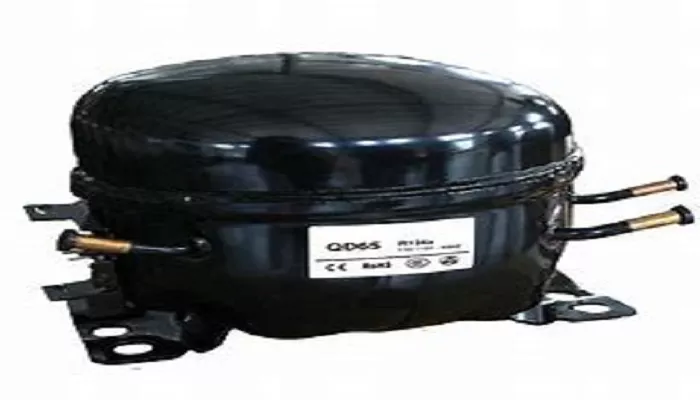The refrigerator is one of the most essential appliances in modern households and commercial settings. It preserves food by maintaining a low temperature, slowing bacterial growth, and preventing spoilage. At the heart of every refrigerator lies the compressor, a critical component responsible for the refrigeration cycle. Without the compressor, a refrigerator cannot function effectively.
Understanding the Refrigeration Cycle
- Compression:The refrigerant gas is compressed, increasing its pressure and temperature.
- Condensation: The high-pressure gas releases heat and condenses into a liquid.
- Expansion:The liquid refrigerant passes through an expansion valve, reducing its pressure and temperature.
- Evaporation:The cold refrigerant absorbs heat from the refrigerator’s interior, turning back into a gas.
The compressor is the driving force behind this cycle, ensuring continuous cooling.
The Function of the Compressor in a Refrigerator
Circulating the Refrigerant
The compressor pumps refrigerant through the refrigeration system, ensuring continuous heat exchange. Without it, the refrigerant would not move, and cooling would stop.
Increasing Refrigerant Pressure and Temperature
The compressor compresses low-pressure refrigerant gas from the evaporator, converting it into a high-pressure, high-temperature gas. This step is necessary for efficient heat dissipation in the condenser.
Maintaining the Refrigeration Cycle
By sustaining pressure differences, the compressor ensures that the refrigerant flows smoothly through the evaporator, condenser, and expansion valve.
Energy Conversion
The compressor converts electrical energy into mechanical energy, driving the refrigerant through the system.
How the Compressor Works
- Suction Phase:The compressor draws in low-pressure refrigerant gas from the evaporator.
- Compression Phase:The gas is compressed, increasing its pressure and temperature.
- Discharge Phase:The high-pressure gas is pushed into the condenser, where it releases heat and turns into a liquid.
This process repeats continuously, maintaining the refrigerator’s cooling effect.
Types of Compressors Used in Refrigerators
Reciprocating (Piston) Compressor
- Uses a piston-cylinder mechanism to compress refrigerant.
- Common in older and heavy-duty refrigerators.
- Provides high efficiency but may produce more noise.
Rotary Compressor
- Uses a rotating mechanism instead of pistons.
- Quieter and more energy-efficient than reciprocating compressors.
- Commonly found in modern refrigerators.
Scroll Compressor
- Uses two spiral-shaped scrolls (one fixed, one moving) to compress refrigerant.
- Highly efficient and durable, with fewer moving parts.
- Often used in premium refrigerators.
Inverter Compressor
- Adjusts speed based on cooling demand, saving energy.
- Reduces wear and tear, extending lifespan.
- Found in high-end, energy-efficient models.
Linear Compressor
- Uses electromagnetic linear motion for compression.
- Extremely quiet and energy-efficient.
- Used in some advanced refrigerators.
Each type has its benefits, but rotary and inverter compressors are increasingly popular due to their efficiency and quiet operation.
Common Compressor Problems & Troubleshooting
Despite being a robust component, compressors can develop issues over time. Common problems include:
Compressor Not Starting
- Possible Causes: Faulty start relay, power issues, or a defective motor.
- Solution: Check electrical connections, test the relay, and consult a technician if needed.
Overheating Compressor
- Possible Causes: Poor ventilation, refrigerant leaks, or excessive workload.
- Solution: Ensure proper airflow, check refrigerant levels, and avoid overloading the fridge.
Loud or Unusual Noises
- Possible Causes: Worn-out internal parts, loose components, or refrigerant issues.
- Solution: Inspect for loose parts, lubricate if necessary, or seek professional repair.
Short Cycling (Frequent On/Off)
- Possible Causes: Faulty thermostat, refrigerant leak, or overheating.
- Solution: Test the thermostat, check refrigerant levels, and clean condenser coils.
Refrigerator Not Cooling Properly
- Possible Causes: Compressor failure, low refrigerant, or blocked airflow.
- Solution: Diagnose refrigerant levels, inspect the compressor, and clean vents.
How to Maintain a Refrigerator Compressor
Clean Condenser Coils Regularly: Dust buildup reduces cooling efficiency.
Ensure Proper Ventilation:Avoid placing the fridge in tight spaces.
Avoid Overloading:Excessive food storage strains the compressor.
Check Door Seals:Damaged seals make the compressor work harder.
Schedule Professional Servicing:Annual inspections prevent major failures.
Energy Efficiency & Compressor Technology
Inverter Technology:Adjusts speed based on cooling needs, saving up to 30% energy.
Eco-Friendly Refrigerants:Newer compressors use R600a (isobutane), which has a lower environmental impact.
Noise Reduction:Improved designs minimize operational noise.
Conclusion
The compressor is the backbone of a refrigerator, driving the refrigeration cycle and ensuring efficient cooling. Understanding its function, types, and maintenance helps users optimize performance and prevent breakdowns.
With advancements in inverter and rotary compressors, modern refrigerators are more energy-efficient and durable than ever. Proper care and timely servicing can significantly extend the compressor’s lifespan, ensuring reliable cooling for years to come.

